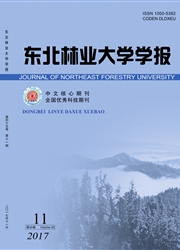

 中文摘要:
中文摘要:
以5年生盆栽南方红豆杉幼苗为试验材料,研究UV—B辐射增强条件下,喷施外源一氧化氮供体硝普钠对南方红豆杉幼苗针叶光合色素质量分数、自由基质量分数、次生代谢物质质量分数等生理指标和生理机制的影响。结果表明:喷施0.1mmol·L^-1 SNP显著增加针叶叶绿素a、叶绿素b、类胡萝卜素及总叶绿素质量分数,提高次生代谢产物质量分数,降低针叶内H2O2质量分数(p〈0.05);UV—B处理显著降低针叶光合色素质量分数及叶绿素a/b,提高紫杉醇质量分数,增加针叶内H2O2质量分数(11.1%,p〈0.05)和羟基自由基(·OH)水平(100%,p〈0.05):与UV—B相比,UV—B+SNP显著降低了针叶H2O2质量分数和·OH水平(p〈0.05)。UV—B+SNP处理下南方红豆杉针叶类黄酮的质量分数((35.40±0.05)mg·g^-1)及单宁的质量分数((30.90±0.31)mg·g^-1)明显高于其他处理(p〈0.05)。研究证实NO作为信号分子可以诱导南方红豆杉提高光合色素质量分数、降低自由基水平、促进次生代谢产物合成积累。
 英文摘要:
英文摘要:
In order to approach the effects of nitric oxide (NO) on the plant physiological characteristics under UV-B radiation, in a pot experiment with five-year old seedlings of Taxus chinensis var. mairei, we studied the effects of sodium nitroprusside (SNP) as the exogenous NO donor on the seedlings physiological characteristics under elevated UV-B radiation. We measured the contents of leaf photosynthetic pigments, free radical and secondary metabolites. Spraying 0.1 mmol·L^-1 SNP increased the leaf chlorophyll a, chlorophyll b, carotenoid, total chlorophyll and secondary metabolites contents significantly (p〈0.05), and decreased the H2O2 content significantly (p〈0.05). UV-B significantly decreased the photosynthetic pigment content and chlorophyll a/b, increased the taxol concentration (p〈0.05), and increased the H2O2(11.1%) and · OH (100%) contents significantly (p〈0.05). Compared with UV-B, UV-B+SNP decreased the leaf H202 and · OH contents significantly (p〈0.05). The contents of flavonoids ( (35.40±0.05)mg · g^-1) and condensed tannins ((30.90±0.31) mg· g^-1 ) had the maximum under the UV-B+SNP. NO as a signal molecule can induce Taxus chinensis var. mairei to im- prove photosynthetic pigment content, decrease the levels of free radicals, promote the synthesis of secondary metabolites, and then adapt to abiotic stress.
 同期刊论文项目
同期刊论文项目
 同项目期刊论文
同项目期刊论文
 期刊信息
期刊信息
